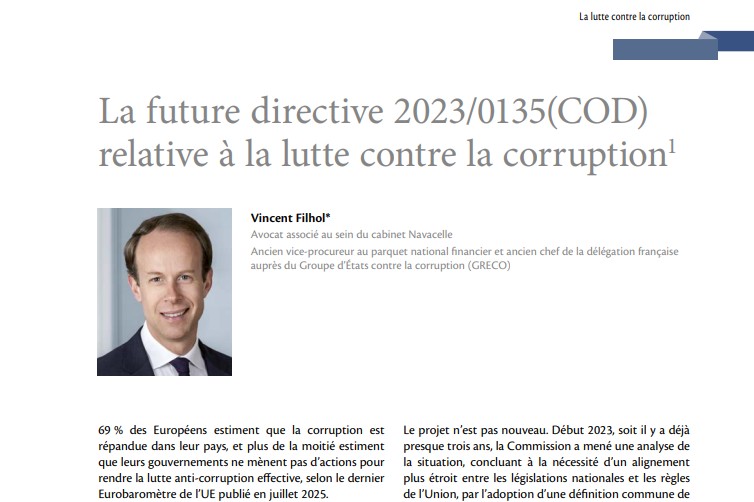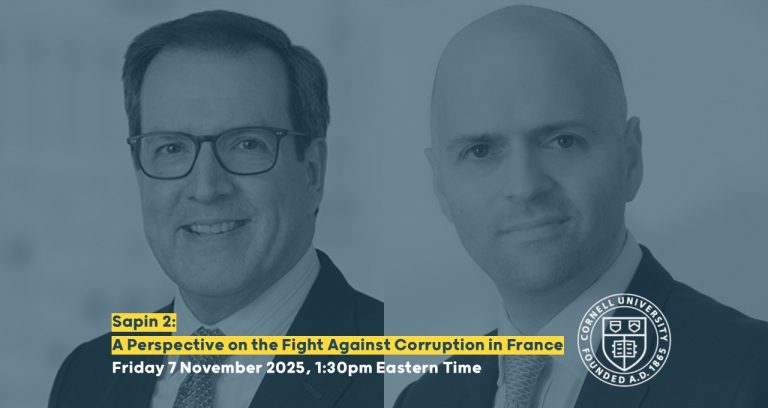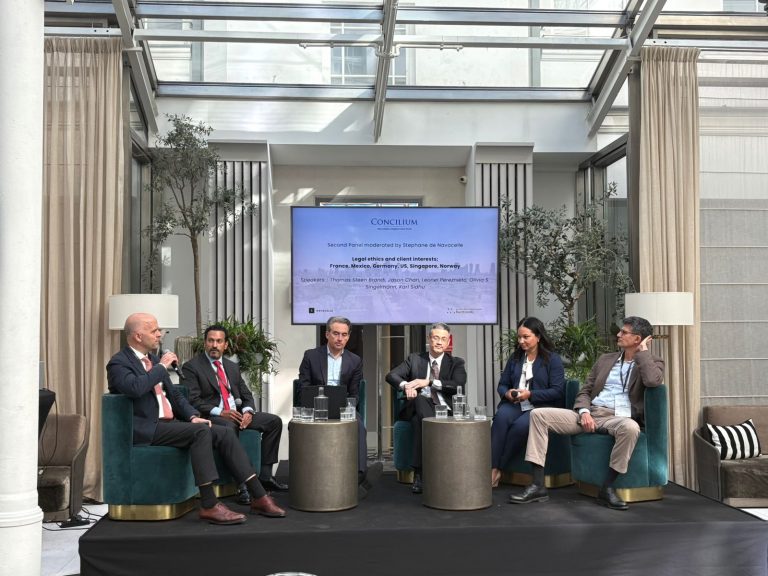Two years after the appointment of its new director, Isabelle Jégouzo, on July 27, 2023, the French Anti-Corruption Agency (AFA) continues to prioritize awareness-raising, advice, and knowledge development regarding breaches of integrity.
A ‘new momentum’, underlying the French Anti-Corruption Agency’s adaptation to new and evolving challenges, particularly through controls and awareness-raising missions.
In July 2025, the AFA published its annual report. Among the key events of 2024 it highlights its reorganisation, the creation of the Observatory of Breaches of Integrity, which has enabled AFA to deepen its understanding of the reality of corruption, and the ongoing development of its work on the impact of organised crime and drug trafficking.
The controls put in place by the AFA also continued apace in 2024, with 17 controls of public actors and 10 initial controls of economic actors. The AFA announced in particular that it had increased controls on regional public entities, increasingly carrying out waves of controls on entities of the same type. In addition, the AFA mentioned that it is increasingly favouring a sectoral approach that allows for coordination between the public and private sectors.
The AFA also reiterated that it had intervened again in 2024 as part of a compliance programme in the context of CJIP.
Finally, among the challenges for the future, the AFA highlights the importance of promoting an ambitious European directive on the fight against corruption, which was proposed by the European Commission in May 2023 and still subject to negotiations to date.
For more information on the issue:
- A look back at the last CJIP of 2024: Areva SA and Orano Mining SAS
- Judicial public interest agreements – Key to understanding French DPA
The third assessment of anti-corruption measures in companies confirms the positive impact of the Sapin II law, while highlighting the ongoing challenges faced by SMEs.
Published in October 2024, this document follows on from the Sapin II law, adopted eight years ago, which requires companies to implement anti-corruption measures. It follows two previous national assessments carried out in 2020 and 2022. This third edition provides an in-depth analysis of how French companies are complying with their legal obligation. It also measures the changes observed since the previous reports and identifies the main difficulties encountered by companies in implementing these measures [1].
“Very good level of knowlegde of corruption and influence peddling sentences.”
A survey was conducted among private companies of various sizes (small and medium-sized enterprises, mid-cap companies, and large groups headquartered in France or abroad) via an anonymous questionnaire, which was mainly fulfilled by ethics and compliance officers [2] on a declarative basis. Two topics were addressed in the survey: awareness of corruption and influence peddling offenses, and the prevention/detection of these offenses.
1/3 of companies faced at least one case of corruption or influence peddling.
Key findings of the survey
* Nearly 1/3 of companies have encountered at least one case
of corruption or influence peddling in the past five years.
Action(s) taken in this case :
Internal investigation : 80%
Disciplinary action : 63%
* 14% companies received requests for facilitation payments
Action(s) taken in this case :
Internal investigation : 88%
* Most exposed functions :
Purchasing : 83%
Commercial functions : 80%
General management : 57%
* Prevention and detection measures :
Yearly update of :
Risk mapping : 42%
Training : 40%
Internal control and evaluation : 33%
* Most difficult measure to put in place
Third-party assessment : 49%
Risk mapping : 29%
Overall, the results highlight a “positive and lasting effect of the Sapin II law” and a “very good level of awareness of corruption and influence peddling offenses,” although the AFA is cautious about biases related to respondents to questionnaire surveys[3]. However, they note greater difficulties for smaller companies in implementing corruption prevention measures and difficulties for some companies in assessing their third parties and mapping their risks. As a result, new publications and tools on these subjects are planned, as well as additions to the guide for SMEs and mid-cap companies published in 2021[4].
AFA publications are becoming increasingly specific and sector-focused
In October 2024, the AFA published a guide for public health institutions, followed by a guide for local elected officials in November 2024.
The guide for public health institutions follows inspections carried out by the AFA, which revealed a specific need to raise awareness among public health actors about the risk of corruption[5]. This sector is particularly relevant in the fight against corruption given the significant social and economic challenges it faces[6] and the risks it entails. The health sector is exposed to significant financial, legal, and reputational risks due to various factors, such as the large financial flows between the public and private sectors, the emergency situations it sometimes has to deal with, increased competition, and partnerships between healthcare institutions and economic actors that produce or market healthcare products[7]. This guide, which complements the AFA Recommendations, is organized around the same three pillars (commitment of the governing body, risk mapping, and risk management) and offers a practical approach, including several case studies illustrating the risks faced by healthcare professionals[8].
For more information on the issue: The launch of controls in healthcare by the French Anti-Corruption Agency
The guide for local elected officials aims to help them manage the risks of integrity breaches, given the particularly high risks to which they are exposed in the course of their duties and responsibilities (land use planning, public service management, public procurement, and support for citizens’ initiatives), for which public spending amounts to approximately €105 billion per year[9]. The AFA, in conjunction with the Association of French Mayors and Intercommunal Presidents, has therefore produced this guide, which is intended to be “operational and practical,” thanks in particular to specific thematic fact sheets, in order to support local elected officials in implementing anti-corruption measures tailored to their specific needs[10].
For more information on the issue: CJIP Paprec : retour sur la répression pénale en cas de violation des règles d’attribution des marchés publics
An analysis of breaches of integrity recorded by French security services shows an 8.2% increase in reports in 2024.
The AFA has carried out analyses of how breaches of integrity are handled. On the one hand, in April 2025, it published a study in partnership with the Ministerial Statistical Service for Internal Security (SSMSI) on breaches of integrity recorded by the security services in 2024, based on data recorded by the police and gendarmerie[11]. This shows, in particular, an 8.2% increase in the number of recorded breaches of integrity compared to 2023[12]. This also shows that Corsica, a French insular region, as well as French overseas have the highest number of breaches, followed by Paris[13]. The offences that increased the most are corruption, illegal taking of interest and favoritism[14]. Related offences, mainly fraud or deception, are regularly linked to offences against integrity[15].
The Integrity Breaches Observatory has published an analysis of first instance decisions relating to integrity violations.
In December 2024, the Integrity Breaches Observatory, which is part of the AFA, published an analysis of first instance decisions from 2021 and 2022 relating to integrity breaches. This document, which is based on 504 court decisions[16] and presents an analysis of criminal offenses, the profiles of defendants, sectors of activity, modus operandi, procedure, and judicial treatment, reveals, for example, that: corruption, in all its forms, is the most common offense against integrity[17], followed by embezzlement of public funds or property[18]. There is a particularly high conviction rate, with 71.7% of cases resulting in a guilty verdict[19]. Furthermore, although 51.6% of court decisions concern the public sector[20], the intertwining of the private and public sectors is a major risk factor for probity offenses in the private sector[21].
For more information on the issue: Lessons from the analysis of first-instance court decisions on probity offenses by the French Anti-Corruption Agency for the years 2021-2022
In conclusion, over the past few months, the AFA has confirmed its central role in the fight against corruption by continuing to produce practical tools, sectoral assessments, and statistical analyses. The AFA has demonstrated its ability to tailor its actions to the specific needs of public and private actors, as evidenced by its guides for healthcare institutions and local elected officials, while continuing to assess the impact of the Sapin II law and thoroughly documenting breaches of integrity through various partnerships, such as with the SSMSI. In view of the persistent weaknesses and difficulties in implementing anti-corruption measures, the AFA is committed to further enhancing its publications and providing targeted tools with a view to continuously improving the prevention and control of risks of breaches of integrity.











